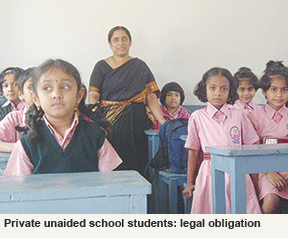 EVER SINCE THE LANDMARK right to Free and Compulsory Education (RTE) Act, 2009, which devolved part of the constitutional obligation of the State (Central, state and local governments) to provide free-of-charge elementary education to all children in the 6-14 age group onto private schools, became law on April 1, 2010, relations between the Karnataka government and the state’s private unaided schools have deteriorated. Under s.12 (1) (c) of the Act, private schools are obliged to reserve 25 percent capacity in class I for children from poor households in their neighbourhood, the cost of which is to be reimbursed by the state government.
EVER SINCE THE LANDMARK right to Free and Compulsory Education (RTE) Act, 2009, which devolved part of the constitutional obligation of the State (Central, state and local governments) to provide free-of-charge elementary education to all children in the 6-14 age group onto private schools, became law on April 1, 2010, relations between the Karnataka government and the state’s private unaided schools have deteriorated. Under s.12 (1) (c) of the Act, private schools are obliged to reserve 25 percent capacity in class I for children from poor households in their neighbourhood, the cost of which is to be reimbursed by the state government.
Typically, instead of interpreting this legislative onus liberally, education officials have interpreted s.12 (1) (c) — which came into force in Karnataka in June 2012 — to increase controls over private unaided schools. First they defined reimbursement as covering only tuition fees (the RTE Act stipulates that the ‘reimbursement’ shall be equivalent to the government’s per capita expenditure on students in its own schools). Next, they assumed the right to determine ‘poor’, ‘neighbourhood’ and the right to nominate students for admission under s.12 (1) (c). Further when in Society for Unaided Private Schools of Rajasthan vs. Union of India & Anr (2012), the Supreme Court controversially upheld s.12 (1) (c) but exempted minority schools, state government officials insisted on certifying minority schools. Moreover, the state government has been taking its own sweet time to reimburse the modest tuition fee — calculated at Rs.11,848 per RTE student per year — payable (regardless of their actual fees structure) to private schools.
Obviously irritated by the state government’s illiberal interpretation of the RTE Act and implementation of s.12 (1) (c), in end February, Karnataka’s 12,254 unaided private schools provoked a major showdown with the Congress state government. On February 22, the Karnataka Unaided Schools Management Association (KUSMA), which has a membership of 1,800 schools statewide, passed a resolution stating that member schools will not admit RTE quota students in the academic year 2014-15, beginning June. KUSMA has demanded that these children be accommodated first in neighbourhood schools run by the state government, local authority (municipal corporation) and private aided schools. Only such students denied admission into government/municipal/private aided schools, will be admitted into private unaided schools under s.12 (1) (c).
“Private unaided schools cannot be asked to enroll children under the 25 percent reservation if seats in government, municipal and private aided schools are going vacant… It is only if there is no physical availability in these schools can the government enroll those children in private unaided schools and even then, not what the parents prefer, but in a randomly selected private unaided school in the neighbourhood (sic)… For the forthcoming academic year 2014-15, members of KUSMA will refuse to admit children under the 25 percent reservation quota,” says the resolution, a copy of which was sent to primary education minister Kimmane Rathnakar and the commissioner for public instruction.
The resolution is a departure from past practice. During the two years past (2011-12 and 2012-13), the state’s private unaided non-minority schools have been admitting students under s.12 (1) (c). Thus far, 150,000 students have been admitted, according to V.R.N. Reddy, president of KUSMA. However, managements of private unaided schools claim to suffer routine harassment from education ministry officials conferred wide discretionary powers to enforce implementation of the reserved quota. “Private unaided schools are expected to continue to admit RTE quota students even though most of them have not received the full fee reimbursement for the first year of implementation. The RTE Act clearly places the onus of providing free and compulsory education upon the government, not on private unaided schools. That’s why KUSMA member schools will henceforth admit RTE quota students only if there are no seats available in government, municipal and aided schools,” says Reddy.
Expectedly, the commissioner for public instruction Mohammad Mohsin has reacted sharply to the KUSMA resolution stating that private unaided schools are obliged by law to reserve 25 percent capacity in class I for poor neighbourhood children. He is unmindful of KUSMA’s charge that the state government has conspicuously failed to implement the infrastructure and facilities mandated by s. 19 and Schedule of the RTE Act in its own schools, which has provoked a flight to private schools.
With an estimated 300,000 applications already received by the education department for admission under the RTE quota for the academic year 2014-15 beginning June, the buzz is the government is likely to use the threat of withdrawal of ‘recognition’ certificates to arm twist private unaided school managements to comply. But with KUSMA adamant about sticking to its resolution and threatening to go to court, a major confrontation is in the offing.
Summiya Yasmeen (Bangalore)



























